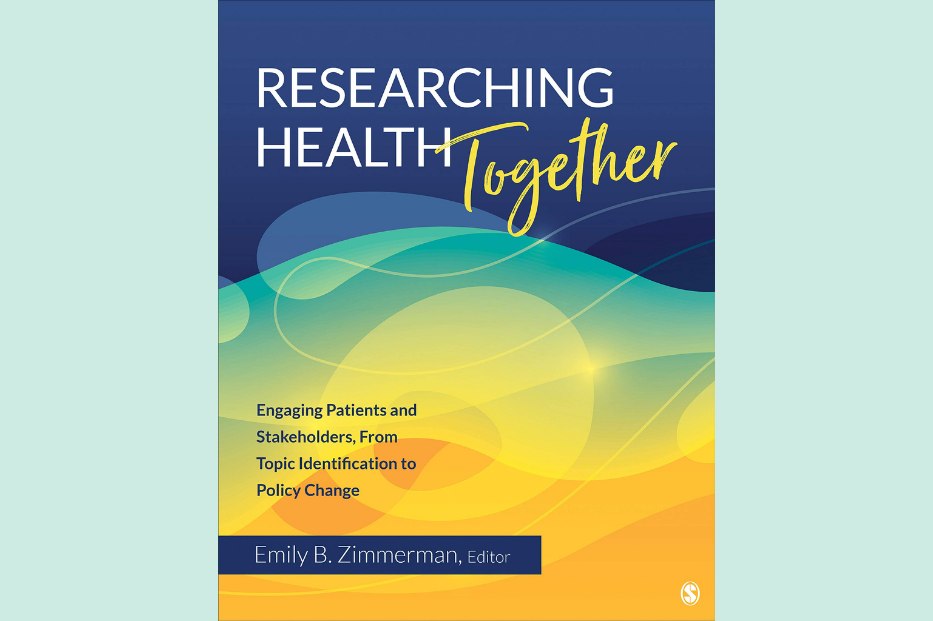5 Questions with Emily Zimmerman

Emily Zimmerman, Ph.D., M.S., MPH, wrote the book on community engaged research – literally.
Released in March, “Researching Health Together: Engaging Patients and Stakeholders, From Topic Identification to Policy Change” features a collection of experiences from researchers across the country, sharing how and why their projects are designed to engage the community.
The Wright Center sat down with Zimmerman, an associate professor in the VCU School of Medicine’s Department of Family Medicine and Population Health, to ask a few questions.
Who is this book for?
This book was developed to meet a range of needs. Most of the chapters in the book are co-authored by research teams that include patients and other stakeholders. I set out to bring together projects that used a wide variety of engagement methods and research approaches. As a researcher, I wanted to reach other researchers who were either new to patient and stakeholder-engaged research or were trying to expand their knowledge and tools by learning from a wide range of projects.

At the same time, the book is set up in a format that is useful for classroom learners, with tools such as discussion questions at the end of each chapter. I also wanted it to be accessible to community partners. Although journal articles on stakeholder engaged research are being published more frequently, they often don’t provide an in-depth description of who was engaged, how they were engaged and how engagement influenced project outcomes. In the book, each chapter focuses on these issues.
What’s the biggest takeaway that you hope a reader has from your book as they look to their own next project?
There are many ways to conduct research in collaboration with communities, patients, and stakeholders and it would be difficult to identify a ‘best’ approach. However, successful projects recognize and incorporate important core principles. Also, by reviewing the lessons learned across projects, it becomes clear that some processes are key to successful engagement.
It’s worth taking the time to plan for things like governance and decision-making, facilitation that minimizes power imbalances, and finding creative ways to include different stakeholder perspectives. For me, a big takeaway is that there are so many methods and approaches that can successfully be implemented in collaborative projects.
What’s an example of a research project that had excellent community engagement and what about it made it so effective?
I think that, across the board, projects with excellent community engagement tend to engage stakeholders in multiple ways and take an iterative approach that incorporates findings or lessons learned. For example, the chapter on Communities Engaged and Advocating for a Smoke-Free Environment describes how an NIH-funded comparative effectiveness trial at Morgan State University was implemented using a multi-phase learning model. Their research process evolved from learning about community priorities through a survey, to developing and implementing an intervention, to identifying changes to the intervention through a collaborative process. For example, they identified the need to move the intervention from a clinical environment to community settings and to incorporate peer motivators. They also used a range of community engagement strategies throughout the process, such as a Community Action Board, task force groups, training community members to provide services and utilizing a community fiscal sponsor.
This book was a collaboration with other Clinical and Translational Science Award (CTSA) hubs. How is that network valuable for a researcher interested in community engagement tactics?
I am continually learning about the value of the CTSA consortium. The CTSA hubs have created very useful tools for conducting stakeholder-engaged research and the sharing that occurs across hubs has been fantastic. In the past few months alone I have used the community-based participatory research Charrette process developed by the University of North Carolina at Chapel Hill, the ResearchMatch tool from Vanderbilt University, the community advisory board approach from the University of Colorado (described in Chapter 9 of the book), and the Community Engagement Studios from the Meharry-Vanderbilt Community Engaged Research Core at Vanderbilt University (described in Chapter 5). It’s great that NIH’s National Center for Advancing Translational Sciences provides funding to encourage collaborative work across the CTSAs to disseminate the tools.
Are there any lessons from the pandemic that have informed how you think about community engaged research and its importance?
Definitely. The importance of community engagement does not diminish because we can’t meet face to face. We have to be present to listen to the community to learn about new needs, challenges, and solutions. The groups I have worked with have been flexible when it comes to meeting virtually and using new tools. I think some of these virtual tools may have even improved the work.
Categories Clinical Research, Collaboration, Community Engagement, Education, Staff